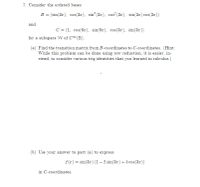
Advanced Engineering Mathematics
10th Edition
ISBN: 9780470458365
Author: Erwin Kreyszig
Publisher: Wiley, John & Sons, Incorporated
expand_more
expand_more
format_list_bulleted
Question

Transcribed Image Text:7. Consider the ordered bases
B = (sin(3x), cos(3x), sin (3x), cos (32), sin(32) cos(3x))
and
C = (1, cos(6x), sin(6x), cos(3x), sin(3x))
for a subspace W of C (R).
(a) Find the transition matrix from B-coordinates to C-coordinates. (Hint:
While this problem can be done using row reduction, it is easier, in-
stead, to consider various trig identities that you learned in calculus.)
(b) Use your answer to part (a) to express
f (x) = sin(3x) (1 – 2 sin(3x) + 5 cos(3x))
in C-coordinates.
Expert Solution
This question has been solved!
Explore an expertly crafted, step-by-step solution for a thorough understanding of key concepts.
This is a popular solution
Trending nowThis is a popular solution!
Step by stepSolved in 4 steps with 3 images

Knowledge Booster
Similar questions
- Please help with the highlighted sections. I have the entire question so you have all the information.arrow_forwardLet B = {(1, 3), (-2,-2)} and B' = {(-12, 0), (-4, 4)} be bases for R², and let 23 = [33] 04 A = R2 relative to B. (a) Find the transition matrix P from B' to B. be the matrix for T: R² ->>> P = 6 9 [V] B [T(V)]B = (b) Use the matrices P and A to find [v] and [T(v)]B, where [V] B¹ = [-4 3]. -12 -1/3 -24 -96 4 -96 4 11 ← (c) Find P-1 and A' (the matrix for T relative to B'). 1/3arrow_forwardLet V be the space spanned by f1= sin x and f 2= cos x. (a) Show that gj = 2sin x + cos x and g2 3cos x form a basis for V. (b) Find the transition matrix from B' = {g1, g2} to B= {f1, f2}. (c) Find the transition matrix from B to B'. (d) Compute the coordinate vector [h] g, where h= 2sin x -Scos and obtain [h]B'. X> | (e) Check your work by computing [h]g' directly.arrow_forward
- X is multivariate Gaussian with "X - [6 8]and C₁ n 608 = and covariance matrix of Y 1 = X1 X2 2 = x1 + x₂ - 2x3 Y3 = x1 + x3 1/2 1/4 1/3 1/4 2 2/3 1/3 2/3 1 = [y₁ У1 У2 уз y3]. Find the mean vector wherearrow_forwardLet B = {ü,,ü,}, B'={v,v,} be two bases in R, where %| ü, %3D 3 (a) Find the transition matrix from B' to B. (b) Find the transition matrix from B to B'.arrow_forward(a) Show that the vector functions are linearly independent on the real line. (b) Why does it follow from Theorem 2 that there is no continuous matrixP(t) such that x1 and x2 are both solutions of x' = P(t)x?arrow_forward
- 5) PLEASE ANSWER EACH QUESTION, THANKS.arrow_forward7. Let be the operator on P[r]3 defined by L(p(x)) = xp'(x) +p"(x) (1) Find the matrix A representing with respect to [1, x, x²]. (2) Find the matrix B representing with respect to [1, x, 1 + x²]. (3) Find the matrix S such that B S-¹ AS. (4) If p(x) = ao + a₁x + a₂(1 + x²), = calculate L¹ (p(x)).arrow_forward
arrow_back_ios
arrow_forward_ios
Recommended textbooks for you
 Advanced Engineering MathematicsAdvanced MathISBN:9780470458365Author:Erwin KreyszigPublisher:Wiley, John & Sons, Incorporated
Advanced Engineering MathematicsAdvanced MathISBN:9780470458365Author:Erwin KreyszigPublisher:Wiley, John & Sons, Incorporated Numerical Methods for EngineersAdvanced MathISBN:9780073397924Author:Steven C. Chapra Dr., Raymond P. CanalePublisher:McGraw-Hill Education
Numerical Methods for EngineersAdvanced MathISBN:9780073397924Author:Steven C. Chapra Dr., Raymond P. CanalePublisher:McGraw-Hill Education Introductory Mathematics for Engineering Applicat...Advanced MathISBN:9781118141809Author:Nathan KlingbeilPublisher:WILEY
Introductory Mathematics for Engineering Applicat...Advanced MathISBN:9781118141809Author:Nathan KlingbeilPublisher:WILEY Mathematics For Machine TechnologyAdvanced MathISBN:9781337798310Author:Peterson, John.Publisher:Cengage Learning,
Mathematics For Machine TechnologyAdvanced MathISBN:9781337798310Author:Peterson, John.Publisher:Cengage Learning,


Advanced Engineering Mathematics
Advanced Math
ISBN:9780470458365
Author:Erwin Kreyszig
Publisher:Wiley, John & Sons, Incorporated

Numerical Methods for Engineers
Advanced Math
ISBN:9780073397924
Author:Steven C. Chapra Dr., Raymond P. Canale
Publisher:McGraw-Hill Education

Introductory Mathematics for Engineering Applicat...
Advanced Math
ISBN:9781118141809
Author:Nathan Klingbeil
Publisher:WILEY

Mathematics For Machine Technology
Advanced Math
ISBN:9781337798310
Author:Peterson, John.
Publisher:Cengage Learning,

